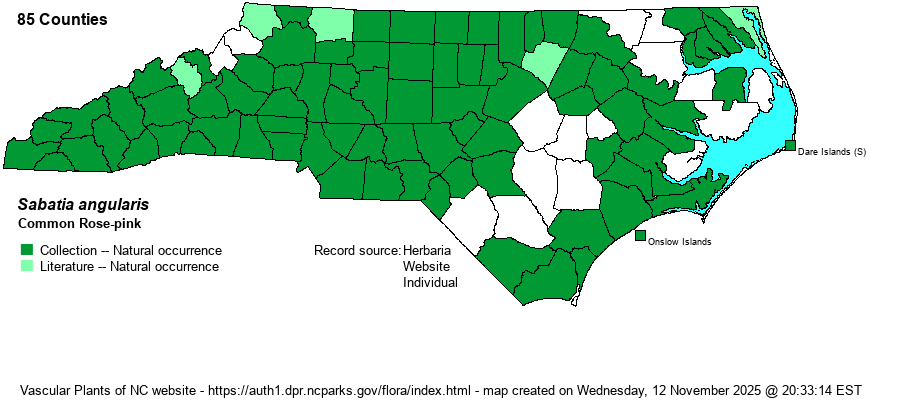| Author | (L.) Pursh | |
| Distribution | Throughout the state, though possibly absent from the northern Mountains and some Coastal Plain counties. The absence of records for the south-central Coastal Plain is odd; though obviously scarce there, the species ought to occur in all of those counties.
This is an Eastern species, quite widespread and found in most counties. It ranges from NY and MO south to western FL and eastern TX. | |
| Abundance | Common in the Piedmont and the southern half of the Mountains. Fairly common in parts of the Coastal Plain, but oddly scarce in others, such as the south-central and southwestern portions; and uncommon in the Sandhills. This is the most widespread and numerous Sabatia in the state, and the only one reasonably statewide in range. | |
| Habitat | This species has a great array of habitats, but mainly found in partial shade in ecotones. It grows along mesic to moist wooded borders, roadbanks, thickets, powerline clearings, openings in bottomlands, meadows, and many other open to partly open places. | |
| Phenology | Blooms in July and August, and fruits in September and October. | |
| Identification | This is a quite familiar species not only to biologists but to the general public, owing to its commonness and its rather large rose-pink flowers. It is the standard Sabatia, growing erect to about 1.5-2 feet tall, with numerous opposite branches and a distinctly 4-angled (square) stem. The scattered opposite stem leaves are ovate to triangular, sessile, and essentially clasp the stem, each about 1-inch long. The inflorescence is a terminal panicle, of numerous rose-pink flowers terminating the branches; each flower has 5 elliptical petals, and the flower averages 1-inch across. As with many Sabatia species, there is a yellow base to the petals, with a narrow red ring separating the yellow from the rose color of the rest of each petal. S. brachiata is somewhat similar, and can grow near S. angularis, but that species has narrow stem leaves with parallel sides, basal leaves are present during flowering, and the stem is somewhat rounded. S. angularis is always a welcome plant to see as you conduct a hot summertime walk along a wooded border. | |
| Taxonomic Comments | None
| |
| Other Common Name(s) | Bitter-bloom, Rose-pink, Common Marsh-pink, American Centaury, Rose Gentian | |
| State Rank | S5 | |
| Global Rank | G5 | |
| State Status | | |
| US Status | | |
| USACE-agcp | FACW link |
| USACE-emp | FAC link |

